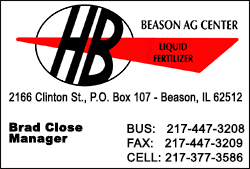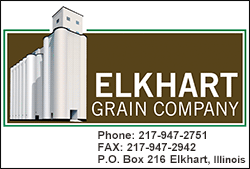|
 The U.S. Department of Agriculture’s (USDA) Risk Management
Agency (RMA) added this flexibility as part of a broader effort
to encourage producers to use cover crops, an important
conservation and good farming practice. Cover crops are
especially important on fields prevented from planting as they
help reduce soil erosion and boost soil health. The U.S. Department of Agriculture’s (USDA) Risk Management
Agency (RMA) added this flexibility as part of a broader effort
to encourage producers to use cover crops, an important
conservation and good farming practice. Cover crops are
especially important on fields prevented from planting as they
help reduce soil erosion and boost soil health.
We work diligently to ensure the Federal crop insurance program
helps producers effectively manage risk on their farms while
also conserving natural resources. We are dedicated to
responding to the needs of producers, and this flexibility is
good for agriculture and promotes climate smart agricultural
practices. We are glad we can better support producers who use
cover crops.
RMA recognizes that cover crops are not planted as an
agricultural commodity but rather with the primary purpose for
conservation benefits. For the 2021 crop year and beyond, RMA
will not consider a cover crop planted following a prevented
planting claim to be a second crop. But RMA will continue to
consider a cover crop harvested for grain or seed to be a second
crop, and it remains subject to a reduction in the prevented
planting indemnity in accordance with the policy.

This decision to allow flexibility for the 2021 crop year and to
make the change permanent for future years builds on the
advanced research and identified benefits cover crops have
supporting healthy soils and cropland sustainability efforts.
Additionally, this decision aligns with the 2018 Farm Bill’s
designation of cover crops as a good farming practice.
More Information
To learn more about this policy change, visit RMA’s Prevented
Planting webpage The webpage also has the latest Cover Crop
Termination Guidelines, which USDA updated in 2019 as a result
of greater flexibilities provided in the 2018 Farm Bill.
Crop insurance is sold and delivered solely through private crop
insurance agents. A list of crop insurance agents is available
at all USDA Service Centers and online at the
RMA Agent Locator. Learn more about crop insurance and the
modern farm safety net at rma.usda.gov
USDA is committed to empowering agricultural producers to
conserve natural resources while strengthening their operations
through voluntary conservation. One of the conservation
practices that can best be leveraged in agriculture is cover
crops.
Nationally, cover crops planted in partnership with NRCS are
shown to sequester the equivalent of approximately 500,000
metric tons of carbon dioxide annually. This is as impactful as
removing nearly 109,000 passenger vehicles from the road each
year. Studies have also shown that cover crops provide increased
corn and soybean yields. While results vary by region and soil
type, cover crops are proven to reduce erosion, improve water
quality and increase the health and productivity of the soil
while building resilience to climate change. Additionally, RMA
provided a premium benefit to producers who planted cover crops
through the Pandemic Cover Crop Program to help producers
maintain cover crop systems amid the financially challenging
pandemic.

USDA touches the lives of all Americans each day in so many
positive ways. In the Biden-Harris Administration, USDA is
transforming America’s food system with a greater focus on more
resilient local and regional food production, fairer markets for
all producers, ensuring access to healthy and nutritious food in
all communities, building new markets and streams of income for
farmers and producers using climate smart food and forestry
practices, making historic investments in infrastructure and
clean energy capabilities in rural America, and committing to
equity across the Department by removing systemic barriers and
building a workforce more representative of America.
USDA Reminds Illinois Producers to File Crop
Acreage Reports
Agricultural producers in Illinois who have not yet completed
their crop acreage reports after planting should make an
appointment with their Farm Service Agency (FSA) office before
the applicable deadline.
An acreage report documents a crop grown on a farm or ranch and
its intended uses. Filing an accurate and timely acreage report
for all crops and land uses, including failed acreage and
prevented planted acreage, can prevent the loss of benefits.
How to File a Report
The following acreage reporting dates are applicable in
Illinois:
July 15, 2021
All spring planted crops, perennial forage,
Cabbage planted 3/15-5/31,
Cucumbers (except Gallatin, Lawrence, and
White counties)
August 15, 2021
Cabbage (planted 6/1 – 7/20)
September 15, 2021
Cucumbers (planted 6/1 – 8/15 in Gallatin, Lawrence,
and White counties)
Service Center staff continue to work with agricultural
producers via phone, email, and other digital tools. Because of
the pandemic, some USDA Service Centers are open to limited
visitors. Contact your Service Center to set up an in-person or
phone appointment.

To file a crop acreage report, you will need to provide:
-
Crop and crop type or variety.
-
Intended use of the crop.
-
Number of acres of the crop.
-
Map with approximate boundaries for the crop.
-
Planting date(s).
-
Planting pattern, when applicable.
Producer shares.
-
Irrigation practice(s).
-
Acreage prevented from planting, when applicable.
-
Other information as required.
Acreage Reporting Details
The following exceptions apply to acreage
reporting dates:
If the crop has not been planted by the acreage reporting date,
then the acreage must be reported no later than 15 calendar days
after planting is completed.
If a producer acquires additional acreage after the acreage
reporting date, then the acreage must be reported no later than
30 calendar days after purchase or acquiring the lease.
Appropriate documentation must be provided to the county office.
Producers should also report crop acreage they
intended to plant, but due to natural disaster, were unable to
plant. Prevented planting acreage must be reported on form
CCC-576, Notice of Loss, no later than 15 calendar days after
the final planting date as established by FSA and USDA’s Risk
Management Agency.
Noninsured Crop Disaster Assistance Program (NAP) policy holders
should note that the acreage reporting date for NAP-covered
crops is the earlier of the dates listed above or 15 calendar
days before grazing or harvesting of the crop begins.
More Information
For questions, please contact your local FSA office. To locate
your local FSA office visit farmers.gov/service-center-locator.
Farm Service Agency Now Accepting
Nominations for County Committee Members

2021 COC Election Schedule
The U.S. Department of Agriculture (USDA) Farm Service Agency
(FSA) began accepting nominations for county committee members
on June 15. Elections will occur in certain Local Administrative
Areas (LAA) for these members who make important decisions about
how federal farm programs are administered locally. All
nomination forms for the 2021 election must be postmarked or
received in the local FSA office by August 2, 2021
Agricultural producers who participate or cooperate in a USDA
program, and reside in the LAA that is up for election this
year, may be nominated for candidacy for the county committee. A
cooperating producer is someone who has provided information
about their farming or ranching operation to FSA, even if they
have not applied or received program benefits. Individuals may
nominate themselves or others and qualifying organizations may
also nominate candidates. USDA encourages minority producers,
women and beginning farmers or ranchers to nominate, vote, and
hold office.
Nationwide, more than 7,700 dedicated members of the
agricultural community serving on FSA county committees. The
committees can be composed of three to 5 members who serve
three-year terms. Producers serving on FSA county committees
play a critical role in the day-to-day operations of the agency.
Committee members are vital to how FSA carries out disaster
programs, as well as conservation, commodity and price support
programs, county office employment and other agricultural
issues.
LAAs are elective areas for FSA committees in a single county or
multi-county jurisdiction. This may include LAAs that are
focused on an urban or suburban area.
More Information
Producers should contact their local FSA office today to
register and find out how to get involved in their county’s
election. They should check with their local USDA Service Center
to see if their LAA is up for election this year. To be
considered, a producer must be registered and sign an FSA-669A
nomination form or an FSA-669-A-3 for urban county committees.
The form and other information about FSA county committee
elections are available at fsa.usda.gov/elections.

Election ballots will be mailed to eligible voters beginning
November 1, 2021. To find your local USDA Service Center, visit
farmers.gov/service-locator.
USDA Microloans Help Farmers Purchase
Farmland and Improve Property
Farmers can use USDA farm ownership microloans to buy and
improve property. These microloans are especially helpful to
beginning or underserved farmers, U.S. veterans looking for a
career in farming, and those who have small and mid-sized
farming operations.
Microloans have helped farmers and ranchers with operating
costs, such as feed, fertilizer, tools, fencing, equipment, and
living expenses since 2013.
Microloans can also help with farmland and building purchases
and soil and water conservation improvements. FSA designed the
expanded program to simplify the application process, expand
eligibility requirements and expedite smaller real estate loans
to help farmers strengthen their operations. Microloans provide
up to $50,000 to qualified producers and can be issued to the
applicant directly from the USDA Farm Service Agency (FSA).
To learn more about the FSA microloan program, contact your
local County USDA Service Center at or visit fsa.usda.gov/microloans.
Maintaining the Quality of Farm-Stored Loan
Grain
Bins are ideally designed to hold a level volume of grain. When
bins are overfilled and grain is heaped up, airflow is hindered
and the chance of spoilage increases.
Producers who take out marketing assistance loans and use the
farm-stored grain as collateral should remember that they are
responsible for maintaining the quality of the grain through the
term of the loan.
Communication is Key in Lending
Farm Service Agency (FSA) is committed to providing our farm
loan borrowers the tools necessary to be successful. FSA staff
will provide guidance and counsel from the loan application
process through the borrower’s graduation to commercial credit.
[to top of second column] |

While it is FSA’s commitment to advise borrowers as they identify
goals and evaluate progress, it is crucial for borrowers to
communicate with their farm loan staff when changes occur. It is the
borrower’s responsibility to alert FSA to any of the following:
Any proposed or significant changes in the farming operation
Any significant changes to family income or expenses
The development of problem situations
Any losses or proposed significant changes in security
If a farm loan borrower can’t make payments to suppliers, other
creditors, or FSA on time, contact your farm loan staff immediately
to discuss loan servicing options.
For more information on FSA farm loan programs, contact your local
County USDA Service Center or visit fsa.usda.gov.
Understanding the U.S. Drought Monitor
Are drought conditions affecting your agricultural operation? The
U.S. Drought Monitor (USDM) is a resource producers can use to help
determine how to best respond and react to a drought as it develops
or lingers.
The USDM is an online, weekly map showing the location, extent, and
severity of drought across the United States. It categorizes the
entire country as being in one of six levels of drought. The map is
released on Thursdays and depicts conditions for the week.
The USDM provides producers with the latest information about
drought conditions where they live, enabling producers to best
respond and react to a drought as it develops or lingers. In some
cases, the USDM may help a producer make specific decisions about
their operation, such as reducing the stocking rate because forage
is not growing. For others, it may provide a convenient big-picture
snapshot of broader environmental conditions.

The USDM incorporates varying data – rain, snow, temperature,
streamflow, reservoir levels, soil moisture, and more – as well as
first-hand information submitted from on-the-ground sources such as
photos, descriptions, and experiences. The levels of drought are
connected to the frequency of occurrence across several different
drought indicators. What makes the USDM unique is that it is not a
strictly numeric product. The mapmakers rely on their judgment and a
nationwide network of 450-plus experts to interpret conditions for
each region. They synthesize their discussion and analysis into a
single depiction of drought for the entire country.
USDA uses the Drought Monitor to determine a producer’s eligibility
for certain drought assistance programs, like the Livestock Forage
Disaster Program and Emergency Haying or Grazing on Conservation
Reserve Program acres.
Additionally, the Farm Service Agency uses the Drought Monitor to
trigger and “fast track” Secretarial Disaster Designations which
then provides producers impacted by drought access to emergency
loans that can assist with credit needs.
Learn more about the U.S. Drought Monitor.
USDA Expands and Renews Conservation Reserve
Program in Effort to Boost Enrollment and Address Climate Change
USDA will open enrollment in the Conservation Reserve Program (CRP)
with higher payment rates, new incentives, and a more targeted focus
on the program’s role in climate change mitigation. Additionally,
USDA is announcing investments in partnerships to increase
climate-smart agriculture, including $330 million in 85 Regional
Conservation Partnership Program (RCPP) projects and $25 million for
On-Farm Conservation Innovation Trials.
Conservation Reserve Program
USDA’s goal is to enroll up to 4 million new acres in CRP by raising
rental payment rates and expanding the number of incentivized
environmental practices allowed under the program. CRP is one of the
world’s largest voluntary conservation programs with a long track
record of preserving topsoil, sequestering carbon, and reducing
nitrogen runoff, as well providing healthy habitat for wildlife.

CRP is a powerful tool when it comes to climate mitigation, and
acres currently enrolled in the program mitigate more than 12
million metric tons of carbon dioxide equivalent (CO2e). If USDA
reaches its goal of enrolling an additional 4 million acres into the
program, it will mitigate an additional 3 million metric tons of CO2
equivalent and prevent 90 million pounds of nitrogen and 33 million
tons of sediment from running into our waterways each year.
New Climate-Smart Practice Incentive
To target the program on climate change mitigation, FSA is
introducing a new Climate-Smart Practice Incentive for CRP general
and continuous signups that aims to increase carbon sequestration
and reduce greenhouse gas emissions. Climate-Smart CRP practices
include establishment of trees and permanent grasses, development of
wildlife habitat, and wetland restoration. The Climate-Smart
Practice Incentive is annual, and the amount is based on the
benefits of each practice type.
Higher Rental Rates and New Incentives
In 2021, CRP is capped at 25 million acres, and currently 20.8
million acres are enrolled. Furthermore, the cap will gradually
increase to 27 million acres by 2023. To help increase producer
interest and enrollment, FSA is:
Adjusting soil rental rates. This enables additional
flexibility for rate adjustments, including a possible increase in
rates where appropriate.
Increasing payments for Practice Incentives from 20% to 50%.
This incentive for continuous CRP practices is based on the cost of
establishment and is in addition to cost share payments.
Increasing payments for water quality practices. Rates are
increasing from 10% to 20% for certain water quality benefiting
practices available through the CRP continuous signup, such as
grassed waterways, riparian buffers, and filter strips.
Establishing a CRP Grassland minimum rental rate. This
benefits more than 1,300 counties with rates currently below the
minimum.
.png)
To learn more about updates to CRP, download our “What’s New with
CRP” fact sheet.
Unauthorized Disposition of Grain
If loan grain has been disposed of through feeding, selling or any
other form of disposal without prior written authorization from the
county office staff, it is considered unauthorized disposition. The
financial penalties for unauthorized dispositions are severe and a
producer’s name will be placed on a loan violation list for a
two-year period. Always call before you haul any grain under loan.
Farm Storage Facility Loans
FSA’s Farm Storage Facility Loan (FSFL) program provides
low-interest financing to producers to build or upgrade storage
facilities and to purchase portable (new or used) structures,
equipment and storage and handling trucks.
The low-interest funds can be used to build or upgrade permanent
facilities to store commodities. Eligible commodities include corn,
grain sorghum, rice, soybeans, oats, peanuts, wheat, barley, minor
oilseeds harvested as whole grain, pulse crops (lentils, chickpeas
and dry peas), hay, honey, renewable biomass, fruits, nuts and
vegetables for cold storage facilities, floriculture, hops, maple
sap, rye, milk, cheese, butter, yogurt, meat and poultry
(unprocessed), eggs, and aquaculture (excluding systems that
maintain live animals through uptake and discharge of water).
Qualified facilities include grain bins, hay barns and cold storage
facilities for eligible commodities.
Loans up to $50,000 can be secured by a promissory note/security
agreement and loans between $50,000 and $100,000 may require
additional security. Loans exceeding $100,000 require additional
security.

Producers do not need to demonstrate the lack of commercial credit
availability to apply. The loans are designed to assist a diverse
range of farming operations, including small and mid-sized
businesses, new farmers, operations supplying local food and farmers
markets, non-traditional farm products, and underserved producers.
To learn more about the FSA Farm Storage Facility Loan, visit
www.fsa.usda.gov/pricesupport or contact your local FSA county
office. To find your local FSA county office, visit
http://offices.usda.gov.
Filing CCC-941 Adjusted Gross Income (AGI)
Certifications
If you have experienced delays in receiving Agriculture Risk
Coverage (ARC) and Price Loss Coverage (PLC) payments, Loan
Deficiency Payments (LDPs) and Market Gains on Marketing Assistance
Loans (MALs), it may be because you have not filed form CCC-941,
Adjusted Gross Income Certification.
If you don’t have a valid CCC-941 on file for the applicable crop
year you will not receive payments. All farm operator/tenants/owners
who have not filed a CCC-941 and have pending payments should
IMMEDIATELY file the form with their recording county FSA office.
Farm operators and tenants are encouraged to ensure that their
landowners have filed the form.
FSA can accept the CCC-941 for 2018, 2019, 2020 and 2021. Unlike the
past, you must have the CCC-941 certifying your AGI compliance
before any payments can be issued.
More information on AGI requirements can be found online at
https://www.fsa.usda.gov/programs-and-services/payment-eligibility/adjusted-gross-income/index.
Environmental Review Required Before Project
Implementation
The National Environmental Policy Act (NEPA) requires Federal
agencies to consider all potential environmental impacts for
federally-funded projects before the project is approved.

For all Farm Service Agency (FSA) programs, an environmental review
must be completed before actions are approved, such as site
preparation or ground disturbance. These programs include, but are
not limited to, the Emergency Conservation Program (ECP), Farm
Storage Facility Loan (FSFL) program and farm loans. If project
implementation begins before FSA has completed an environmental
review, the request will be denied. Although there are exceptions
regarding the Stafford Act and emergencies, it’s important to wait
until you receive written approval of your project proposal before
starting any actions.
Applications cannot be approved until FSA has copies of all permits
and plans. Contact your local FSA office early in your planning
process to determine what level of environmental review is required
for your program application so that it can be completed timely.
[Illinois/USDA-FPAC] |